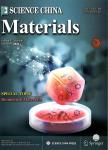二维金属偶氮盐框架用于高效二氧化碳光还原
2D metal azolate framework for efficient CO2 photoreduction作者机构:Department of ChemistryXinzhou Normal UniversityXinzhou 034000China College of ScienceQiongtai Normal UniversityHaikou 571100China National&Local United Engineering Laboratory for Power BatteriesKey Laboratory of Polyoxometalate Science of Ministry of EducationDepartment of ChemistryNortheast Normal UniversityChangchun 130024China School of Chemical and Environmental EngineeringChangchun University of Science and TechnologyChangchun 130022China
出 版 物:《Science China Materials》 (中国科学(材料科学)(英文版))
年 卷 期:2024年第67卷第8期
页 面:2637-2644页
核心收录:
学科分类:083002[工学-环境工程] 0830[工学-环境科学与工程(可授工学、理学、农学学位)] 081704[工学-应用化学] 081705[工学-工业催化] 07[理学] 070304[理学-物理化学(含∶化学物理)] 08[工学] 0817[工学-化学工程与技术] 0703[理学-化学]
基 金:financially supported by the National Natural Science Foundation of China(NSFC)(22371033,22175033,and 22266028) the Outstanding Young Technology Talent Foundation of Jilin Province(20230508108RC) the Fundamental Research Funds for the Central Universities(2412019FZ007) the Natural Science Foundation of Hainan Province(823MS062) the Foundation of Xinzhou Teachers University(2021KY07) the Science and Technology Innovation Project of Higher Education in Shanxi Province(2021L450) the Youth Science Research Project of Shanxi Province(202103021223362)
主 题:光还原 表面活性位 能源短缺 二维结构 二氧化碳 三维结构 传输路径 全球变暖
摘 要:由可见光驱动的将CO_(2)转化为高附加值燃料是一种清洁可再生的技术,有助于控制全球变暖和应对能源短缺.近年来,二维的金属偶氮盐框架(2D MAFs)因其特定的电子传输路径、高度暴露的表面活性位点及可调节的吸光能力,在CO_(2)光还原研究中备受关注.然而,对其在该领域的研究仍处于初级阶段.本文设计了一种新型二维MAFs(compound 1),通过四-(4-四唑基苯基)乙烯(H;4;TTPE)与钴的自组装实现了对CO_(2)的光还原.作为对比,通过类似的合成过程构建了具有三维结构的compound 2.非均相光催化实验结果显示,2D compound 1的光还原性能明显优于3D compound 2,在相同条件下,其CO产率高达11.56 mmol g^(-1)h^(-1),是compound 2(1.94 mmol g^(-1)h^(-1))的6倍.这一性能优势源于compound 1独特的二维结构,其不仅具有有利于CO_(2)还原的能级,还能在整个CO_(2)光还原过程中促进电子-空穴高效分离.本工作为设计适用于高效CO_(2)光还原的2D MAFs光催化剂指引了方向.



